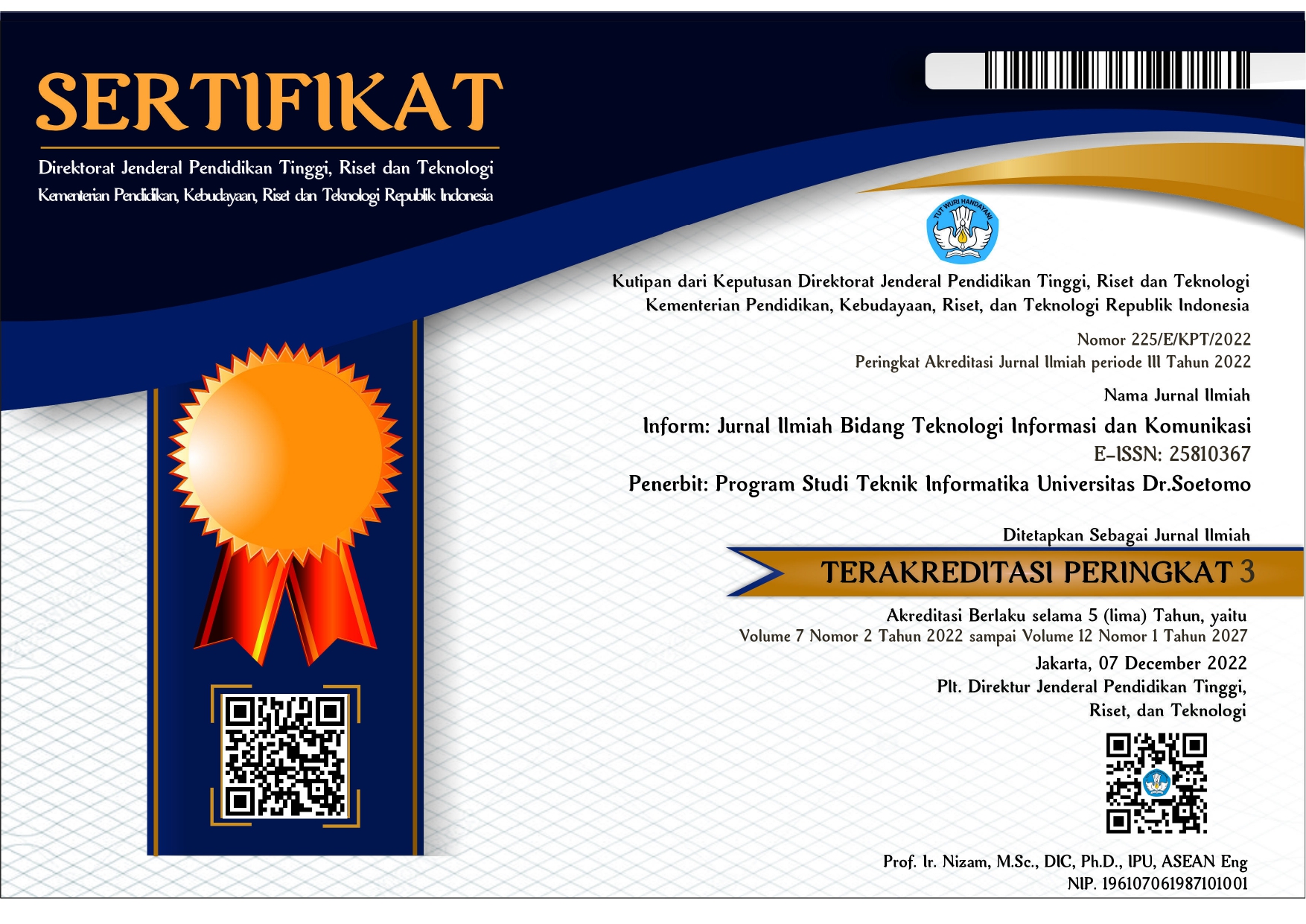Grouping Student Awareness on Security Of E-Learning Information Using Fuzzy C-Means Method
 Abstract views: 243
,
Abstract views: 243
,
 PDF downloads: 243
PDF downloads: 243
Abstract
Many educational institutions have been forced to adapt how they present the teaching and learning process, including the creation of appropriate learning media due to the current Covid-19 pandemic. This is accomplished through the development of an integrated online learning system known as E-Learning. Aside from all of the benefits and positive outcomes that E-Learning can give, there are also drawbacks to student information security, such as assignment theft, piracy of E-Learning, the misuse of passwords by irresponsible students, and other problems. To anticipate this, the researcher intended to group students' awareness of their respective E-Learning information security by using the Fuzzy C Means method. Fuzzy C Means uses a fuzzy grouping model so that data can be members of all classes or clusters formed with different degrees or levels of membership between 0 to 1. The sample used to represent the population is 20 students of STIKOM PGRI Banyuwangi, Indonesia. The results obtained are to find out how well the grouping of student awareness clusters on E-Learning information security. There are 3 clusters of student E-Learning information security awareness. Cluster 1 consists of students with high awareness, cluster 2 contains categories of students with low awareness, and the third cluster consists of students with moderate awareness.
References
Yodha, S., Abidin, Z., & Adi, E, “Student Perceptions of the Implementation of E-Learning in Information Systems Management Course. Jurusan Teknologi Pendidikan Universitas Negeri Malang”, Jurnal Kajian Teknologi Pendidikan, vol.1 no.3, 2019.
T. S. J. Arifin, N. Natassa, D. Khoirunnisa, and R. Hendrowati, "The Level of Student Satisfaction with the Online Learning Process During a Pandemic Using the K-means Algorithm," Inf. J. Ilm. Bid. Teknol. Inf. dan Komun., vol. 6, no. 2, pp. 123–126, 2021.
Yanto, Y, “Analysis of the Factors Affecting the Level of Use of the E-Mail Security System in Indonesia”, STRING (Satuan Tulisan Riset Dan Inovasi Teknologi), vol.3, no.3, 2019.
S. D. Setiarini and S. R. Wulan, "Analysis Software Engineering Team's Soft Skills Learning using Online Learning Platform with Project-Oriented Problem-Based Learning (POPBL)," Inf. J. Ilm. Bid. Teknol. Inf. dan Komun., vol. 6, no. 2, pp. 81–86, 2021.
A. Matz, "Customer Loyalty Clustering Model Using K-Means Algorithm with LRIFMQ Parameters," Inf. J. Ilm. Bid. Teknol. Inf. dan Komun., vol. 5, no. 2, pp. 54–61, 2020.
W. Maghfiroh and N. Ulinnuha, "Application of Fuzzy C-Means in Grouping Districts/Cities Based on Health Service Facilities in East Java," Inf. J. Ilm. Bid. Teknol. Inf. dan Komun., vol. 3, no. 2, pp. 62–68, 2018.
A. F. Wardatul Maghfiroh, Nurissaidah Ulinnuha, “Penerapan Fuzzy C-Means dalam Mengelompokkan Kabupaten/Kota Berdasarkan Fasilitas Pelayanan Kesehatan Di Jawa Timur,” Inf. J. Ilm. Bid. Teknol. Inf. dan Komun., vol. 4, no. 1, pp. 8–14, 2019.
Wirawan, R, "Study of Competence and Awareness of E-Learning Users on E-Learning System Security in Higher Education", ETHOS (Jurnal Penelitian Dan Pengabdian), vol.7, no.1, 2019.
Nasher, F, “Design of Information Security Management System for Procurement of Goods/Services Electronically (Lpse) at Dinas Komunikasi Dan Informatika Kabupaten Cianjur Dengan Menggunakan Sni Iso/Iec 27001:2013”, Media Jurnal Informatika, vol. 10, no.1, 2020.
Yunita, F, "Application of Data Mining Using the K-Means Clustering Algorithm for New Student Admissions. Sistemasi", vol.7, no.33, 2018.
Ramadhan, A., Mustakim, & Handinata, R, "Implementation of Fuzzy C Means and Moora Algorithm for Grouping and Determination of Flood Disaster Management Areas". November, Pekanbaru, 2019.
Alif, M. S., & Pratama, A. R, Analysis of Security Awareness Among E-Wallet Users in Indonesia. automata, vol.2, no.1, 2021.
Aid, D., Case, P., Kec, S. P., & Kab, N. (n.d.), "Application of Fuzzy C-Means in a Decision Support System for Determination of Beneficiaries of Community Direct Assistance (BLM) PNPM- MPd (Case study) PNPM-MPd Kec . Ngadirojo Kab . Pacitan)", The Government of Indonesia launched the National Empowerment Program Mas. 264–273, 2007
Kemala, R. F., Astuti, I. F., & Maharani, S, “Application of the Fuzzy C-Means Method in the TOEFL Simulation Application (Test Of English As A Foreign Language) Berbasis Web ( Case Study : Fakultas MIPA Universitas Mulawarman)”, Informatika Mulawarman : Jurnal Ilmiah Ilmu Komputer, vol.14, no.11, 2019.
Putra, H. T, “BASED ON ROASTING RESULTS USING FUZZY C - MEANS ALGORITHM”, LAPORAN SKRIPSI Oleh : HAYUANGGA TINNO PUTRA KUSUMA JURUSAN TEKNIK INFORMATIKA.
Simbolon, C. L., Kusumastuti, N., & Irawan, B, "Clustering of graduates from Mathematics and Natural Sciences Faculty of Mathematics and Natural Sciences Untan Pontianak uses the fuzzy c - means algorithm”. Buletin Ilmiah Mat. Stat. Dan Terapannya (Bimaster), vol.02, no.1, 2013.
Copyright (c) 2022 Yoyon Arie Budi Suprio, M. Rizky Maulana

This work is licensed under a Creative Commons Attribution-ShareAlike 4.0 International License.
Authors who publish with Inform: Jurnal Ilmiah Bidang Teknologi Informasi dan Komunikasi agree to the following terms:
-
Authors retain copyright and grant the journal right of first publication with the work simultaneously licensed under a Creative Commons Attribution License (CC BY-SA 4.0) that allows others to share the work with an acknowledgment of the work's authorship and initial publication in this journal.
-
Authors are able to enter into separate, additional contractual arrangements for the non-exclusive distribution of the journal's published version of the work (e.g., post it to an institutional repository or publish it in a book), with an acknowledgment of its initial publication in this journal.
-
Authors are permitted and encouraged to post their work online (e.g., in institutional repositories or on their website) prior to and during the submission process, as it can lead to productive exchanges, as well as earlier and greater citation of published work.













